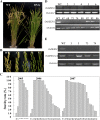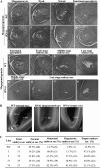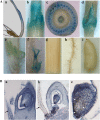The rice wall-associated receptor-like kinase gene OsDEES1 plays a role in female gametophyte development
- PMID: 22885936
- PMCID: PMC3461549
- DOI: 10.1104/pp.112.203943
The rice wall-associated receptor-like kinase gene OsDEES1 plays a role in female gametophyte development
Abstract
The wall-associated kinase (WAK) gene family is a unique subfamily of receptor-like kinases (RLKs) in plants. WAK-RLKs play roles in cell expansion, pathogen resistance, and metal tolerance in Arabidopsis (Arabidopsis thaliana). Rice (Oryza sativa) has far more WAK-RLK genes than Arabidopsis, but the functions of rice WAK-RLKs are poorly understood. In this study, we found that one rice WAK-RLK gene, DEFECT IN EARLY EMBRYO SAC1 (OsDEES1), is involved in the regulation of early embryo sac development. OsDEES1 silencing by RNA interference caused a high rate of female sterility. Crossing experiments showed that female reproductive organs lacking OsDEES1 carried a functional defect. A detailed investigation of the ovaries from OsDEES1 RNA interference plants indicated that the knockdown of OsDEES1 expression did not affect megasporogenesis but that it disturbed female gametophyte formation, resulting in a degenerated embryo sac and defective seed formation. OsDEES1 exhibited a tissue-specific expression pattern in flowers and seedlings. In the ovary, OsDEES1 was expressed in the megagametophyte region and surrounding nucellus cells in the ovule near the micropylar region. OsDEES1 was found to be a membrane-localized protein with a unique sequence compared with other WAK-RLKs. These data indicate that OsDEES1 plays a role in rice sexual reproduction by regulating female gametophyte development. This study offers new insight into the functions of the WAK-RLK family.
Figures






Similar articles
-
The Wall-associated Kinase gene family in rice genomes.Plant Sci. 2014 Dec;229:181-192. doi: 10.1016/j.plantsci.2014.09.007. Epub 2014 Sep 22. Plant Sci. 2014. PMID: 25443845
-
Evolutionary expansion, gene structure, and expression of the rice wall-associated kinase gene family.Plant Physiol. 2005 Nov;139(3):1107-24. doi: 10.1104/pp.105.069005. Plant Physiol. 2005. PMID: 16286450 Free PMC article.
-
Global analysis of expression profiles of rice receptor-like kinase genes.Mol Plant. 2012 Jan;5(1):143-53. doi: 10.1093/mp/ssr062. Epub 2011 Jul 16. Mol Plant. 2012. PMID: 21765177
-
Receptor-like protein kinases in plant reproduction: Current understanding and future perspectives.Plant Commun. 2021 Dec 29;3(1):100273. doi: 10.1016/j.xplc.2021.100273. eCollection 2022 Jan 10. Plant Commun. 2021. PMID: 35059634 Free PMC article. Review.
-
Challenges in understanding RLK function.Curr Opin Plant Biol. 1998 Oct;1(5):388-92. doi: 10.1016/s1369-5266(98)80261-6. Curr Opin Plant Biol. 1998. PMID: 10066619 Review.
Cited by
-
WAKL8 Regulates Arabidopsis Stem Secondary Wall Development.Plants (Basel). 2022 Sep 2;11(17):2297. doi: 10.3390/plants11172297. Plants (Basel). 2022. PMID: 36079678 Free PMC article.
-
OsRH52A, a DEAD-box protein, regulates functional megaspore specification and is required for embryo sac development in rice.J Exp Bot. 2024 Aug 28;75(16):4802-4821. doi: 10.1093/jxb/erae180. J Exp Bot. 2024. PMID: 38642102 Free PMC article.
-
The Role of INAPERTURATE POLLEN1 as a Pollen Aperture Factor Is Conserved in the Basal Eudicot Eschscholzia californica (Papaveraceae).Front Plant Sci. 2021 Jul 7;12:701286. doi: 10.3389/fpls.2021.701286. eCollection 2021. Front Plant Sci. 2021. PMID: 34305989 Free PMC article.
-
MORE FLORET1 Interacts with C-type Replication Protein A Complex and Regulates Male Meiosis in Rice.Rice (N Y). 2025 Apr 26;18(1):30. doi: 10.1186/s12284-025-00791-7. Rice (N Y). 2025. PMID: 40285806 Free PMC article.
-
Genome-wide identification and characterization of wall-associated kinases, molecular docking and polysaccharide elicitation of monoterpenoid indole alkaloids in micro-propagated Catharanthus roseus.J Plant Res. 2024 Jan;137(1):125-142. doi: 10.1007/s10265-023-01504-1. Epub 2023 Nov 14. J Plant Res. 2024. PMID: 37962734
References
-
- Anderson CM, Wagner TA, Perret M, He ZH, He D, Kohorn BD. (2001) WAKs: cell wall-associated kinases linking the cytoplasm to the extracellular matrix. Plant Mol Biol 47: 197–206 - PubMed
-
- Bajon C, Horlow C, Motamayor J, Sauvanet A, Robert D. (1999) Megasporogenesis in Arabidopsis thaliana L.: an ultrastructural study. Sex Plant Reprod 12: 99–109
-
- Bencivenga S, Colombo L, Masiero S. (2011) Cross talk between the sporophyte and the megagametophyte during ovule development. Sex Plant Reprod 24: 113–121 - PubMed
Publication types
MeSH terms
Substances
LinkOut - more resources
Full Text Sources
Other Literature Sources

